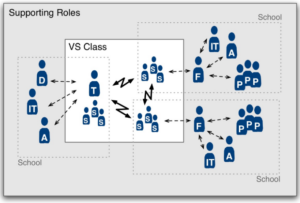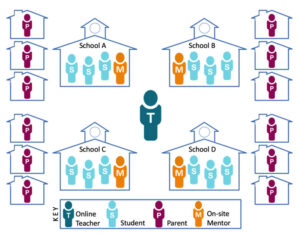As was described earlier this week, on 15 March 2019 the Government of Ontario announced the Education that Works for You – Modernizing Classrooms proposed policy. In light of that announcement, there has been a lot of misinformation about what is online learning and what does it look like in the context of e-learning in Ontario.
It is important to begin by underscoring the fact that e-learning in Ontario is not a student in a room by themselves or at home, logged into a computer where they complete online content without interacting with a teacher online or another human in person. This is the old correspondence model of distance education, which still does exist in Canada (and even in Ontario in small pockets). A student completing homework from paper-based packets, which they would mail back to a grader at some centralized location with no interaction from another living soul, is likely the model of distance education that most individuals are familiar with. As such, at times it is the model of distance education that gets applied to other mediums – such as online learning or e-learning – particularly when first implemented. The good news is that online learning or e-learning in Ontario has a rich history that dates back approximately two decades and those authorities in Ontario that are interested in operating good e-learning programs have numerous other models of distance education to help guide them.
According to the Ministry of Education the definition for e-learning in Ontario is:
E-learning refers to the use of the tools of the Provincial vLE/LMS when there is a scheduled distance between the e-learning teacher and students and/or students and each other. Distance may be related to location (i.e. students from different locations enrol in one e-learning course) or time (i.e. students from one location enrol in one course but access it during different periods of the day). (p. 2)
The key points in this definition are that the student and subject matter expert teacher are separated by distance (i.e., location or time), and instruction is provided through technology-mediated tools. For example, a student who is enrolled in mathematics during a period 2 course at High School X is being taught by a mathematics teacher that is either a) located at High School Y, or b) teaching physics in another classroom during period 2. It is important to note that the definition for e-learning does not mention any other humans or any supports that the e-learning program or the school may or may not provide. However, the Ministry of Education does provide guidance on how schools should implement e-learning that includes:
- assigning personnel for the delivery of the Provincial e-Learning Strategy, including a contact person who will be the liaison with the Ministry on matters pertaining to the strategy;
- establishing class sizes and Pupil Teacher Ratios as outlined in provincial and school board policies and as specified in the applicable collective agreement;
- ensuring e-learning and blended learning courses are part of the teacher’s “workload” as specified in the applicable collective agreement;
- ensuring that day school students enrolled in day school e-learning courses are taught by day school grid teachers and placed on the day school funding register;
- ensuring that all students, including those with special needs, have equitable access to appropriate e-learning opportunities and support within e-learning courses;
- ensuring that students who enrol in a secondary school e-learning course are registered in the home school, as defined in enrolment register instructions;
- ensuring adequate program support for all students, including those with special needs, and making the delivering school aware of these needs prior to enrolment in the course (e.g., orientation sessions);
- providing a location and proctor for summative evaluations (e.g., final examination, culminating activity), if required, and ensuring the return of the completed examination to the e-learning teacher by a date pre-determined by the delivering teacher, in compliance with teacher workload;
- providing an orientation program to students taking their e-learning courses to validate the student’s suitability for e-learning and to prepare them for this style of learning; and
- ensuring that e-learning teachers make themselves available to students at scheduled times to support e-learning students. (pp. 7-10)
This list includes a lot of human interaction – both in person and online, as well as a lot of support that schools and school boards are required to provide in order to be allowed to use the Ministry of Education’s tools and resources in their e-learning programs.
What this list of required interactions and supports should create is an environment like this:

Figure 1. (Davis & Niederhauser, 2007)
In this kind of environment, the students (S) are enrolled in one of three brick-and-mortar schools. The online teacher (T) is also enrolled in one of these three schools. At each school, the students have access to the school-based administrator (A), local IT support (IT), and a facilitator (F).
A more recent model that has been developed based on research that has focused on schools in Michigan (i.e., the first jurisdiction in North American to have an online learning graduation requirement), and looks slightly different but contains many consistent elements.

Figure 2. (Borup, Chambers, & Stimson, 2018)
In this model, there are students (S) attending four separate schools, who are being taught by an online teacher (T) that isn’t based in any of the four schools. In each of the schools there is a mentor (M). As is the case with all students, in some of the homes there is a parent/guardian (P) that is able to help and provide some support, but in other cases that source of support is not available for any variety of reasons.
In both models, the presence of a school-based individual (i.e., facilitator or mentor) is included – as it required by the e-Learning Ontario Master User Agreement. Barbour and Mulcahy (2004) described the role of this facilitator or mentor as providing initial maintenance and troubleshooting for the technology; to provide support (although not academic support) in gaining the independent learning and self-motivation skills that may be needed to succeed in the online environment; and to proctor tests and exams, monitor student attendance and behavior, and provide supervision; while Ferdig, Cavanaugh, DiPietro, Black, & Dawson (2009) described the role as assisting in registering and accessing virtual courses, providing academic tutoring and assistance to students, facilitating technical support, and acting as an academic advisor to students enrolled. In a detailed fashion, Borup, Chambers, and Stimson (2018) wrote this of the facilitator or mentor:
On-site mentors are not meant to replace the online teacher but to enhance and support the work that online teachers are currently doing. On-site mentors’ physical presence also allows them to provide types of support that are difficult for online teachers. More specifically, as the content experts, teachers are primarily charged with providing students with content-related support. Teachers are also responsible for assessing students’ understanding of the course material and their ability to apply their understanding in authentic ways. On-site mentors are primarily charged with developing relationships with students and motivating them to engage fully in learning activities. Mentors are also charged with helping students develop the communication skills, organizational skills, and study skills to effectively learn online. When working with multiple students, mentors can also promote co-presence and collaboration… [The online] teacher’s primary responsibility is to teach the content, and mentors’ primary responsibilities are to ensure “everything is working smoothly and order is maintained… In practice, there is “considerable overlap” between online teachers’ and on-site mentors’ facilitating efforts, and on-site facilitators can at times act as teachers and online teachers can act as facilitators. (para. 4)
The present model of e-learning that exists in most programs in Ontario is consistent with the requirements outlined by the Ministry of Education, which is reflected in the images and descriptions above. It is also important to note that while there are in-person interactions in these models, this is not blended learning. Blended learning is defined by e-Learning Ontario as:
E-learning is distinct from blended learning. Blended learning refers to the use of the tools of the Provincial vLE/LMS that intersect with the teaching and learning in a scheduled face-to-face classroom. Unlike e-learning classes where there is a scheduled distance between students and teacher and/or students and each other, blended learning occurs within the context of an assigned face-to-face class in one board with daily physical attendance. (p. 3)
Within the research literature, the most commonly accepted definition of blended learning is Graham’s (2006) definition, which states that “blended learning systems combine face-to-face instruction with computer-mediated instruction” (such as online learning). The key focus in these definitions is the fact that the teacher who has the subject matter expertise and provides the content-based instruction is located in the same place and time as the students. So the above models, due to the fact that the teacher is separated from the students by geography and/or time, meet the Ontario definition of e-learning (and the definition of online learning based on the larger field).
At the end of the day, both the Ministry of Education requirements and the model of e-learning that most programs in Ontario have implemented is to focus on providing students with every opportunity to have success. In order to be successful in any educational setting, students need to engage in an affective, behaviour, and cognitive manner. Every student enters the setting with certain individual characteristics in these three areas (i.e., the black area). Between a student’s community, their family, and their school, there are supports that already exist to help the student achieve full engagement in their learning (i.e, the red area). The goal of the e-learning program is to provide the necessary supports to make up the difference between what the student already possesses and is able to gain from their existing community AND the level of engagement that is needed for the student to be successful.
The nature of those supports provided by the e-learning program must differ based on the specific needs of different populations of students. Well designed and implemented e-learning programs seek to provide those supports. Based on research into e-learning in Ontario, along with our own network of e-learning practitioners and administrators in the province, CANeLearn believes that the model of e-learning that exists in most programs in Ontario seeks to be consistent with this model of student support.
References:
Barbour, M. K., & Mulcahy, D. (2004). The role of mediating teachers in Newfoundland ‘s new model of distance education. The Morning Watch, 32(1). Retrieved from http://www.mun.ca/educ/faculty/mwatch/fall4/barbourmulcahy.htm
Borup, J., Chambers, C. B. & Stimson, R. (2018). Helping online students be successful: Student perceptions of online teacher and on-site mentor facilitation support. Lansing, MI: Michigan Virtual University. Retrieved from https://mvlri.org/research/publications/helping-online-students-be-successful-student-perceptions-of-support/
Borup, J., Graham, C. R., & Archambault, L. (2019, March). Revisiting the adolescent community of engagement framework. A roundtable presentation at annual conference for the Society for Information Technology and Teacher Education, Las Vegas, NV.
Davis, N., & Niederhauser, D. S. (2007). Virtual schooling. Learning & leading with technology, 34(7), 10-15. Retrieved from https://files.eric.ed.gov/fulltext/EJ779830.pdf
Ferdig, R. E., Cavanaugh, C., DiPietro, M., Black, E. W., & Dawson, K. (2009). Virtual schooling standards and best practices for teacher education. Journal of Technology and Teacher Education, 17(4), 479-503.
Graham, C. R. (2006). Chapter 1: Blended learning system: Definition, current trends, future directions. In C. J. Bonk & C. R. Graham (Eds.), Handbook of blended learning (pp. 3-21). San Francisco, CA: Pfeiffer.